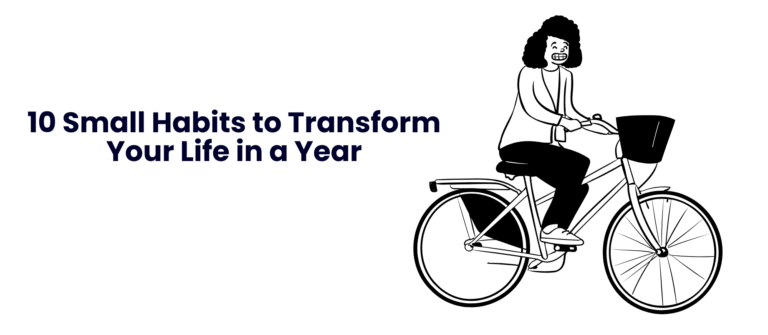The Ultimate Guide to Building Habits That Stick (2025)
The first time I truly started researching habits, I realized something shocking—I was operating on autopilot. Every small action I took throughout the day, from checking my phone first thing in the morning to eating at odd hours, was part of a habit system I had unknowingly built.
That realization sent me down a rabbit hole. For months, I devoured books, watched videos, and tested different techniques to take control of my habits. I wanted to break old, unhelpful routines and build new ones deliberately.

At first, I succeeded. But then, I made a classic mistake—I assumed that because I “knew” how habits worked, I didn’t need to be as conscious about maintaining them.
That was the trap that led to my failure.
In 2021, I decided to focus on my health again. I crafted a perfect morning routine:
- Wake up at 6 AM (instead of my usual 7:30 AM)
- Exercise for 30 minutes (running, weight training, meditation)
- Read and journal
- Then start my workday
Guess what happened? I failed in less than a week.
And it wasn’t just a small slip-up—I completely stopped exercising.
The problem? I tried to do too much, too fast. I set unrealistic expectations and overloaded myself with too many changes at once. That failure forced me to go back to the drawing board.
So I wrote this guide—not just for you, but for myself. I needed to rethink habit formation, study it from scratch, and apply what truly works.
Let’s get into it.
How Habits Work (And Why They Control Your Life)
A habit is any behavior you do so often that it becomes automatic. You don’t need to think about brushing your teeth—you just do it. That’s the power of habit.
The Habit Loop: Cue → Routine → Reward
Charles Duhigg, in his book The Power of Habit, explains that habits work in a three-part loop:
1️⃣ Cue (Trigger): A signal that reminds you to perform a habit
2️⃣ Routine: The actual habit or action
3️⃣ Reward: A positive feeling that reinforces the habit
Example: Morning Coffee Habit
- Cue: You wake up
- Routine: You make coffee
- Reward: You feel awake and energized
Over time, the cue becomes so strong that your brain automatically executes the routine.
Want to build a new habit? Attach it to an existing cue—this is called habit stacking (more on that later).
How Habits Are Formed in the Brain (And Why Some Stick While Others Fail)
The human brain is an incredibly efficient machine. It automates repetitive tasks to conserve energy, which is why habits exist in the first place. Understanding how habits are wired in the brain can help you design better ones and break old ones that don’t serve you.
The Basal Ganglia: Your Brain’s Habit Center
When you start working on a new habit, your prefrontal cortex (the part of your brain responsible for decision-making) is actively involved. This means it requires conscious effort to perform the action.
However, the brain doesn’t like wasting energy on repetitive tasks. So, over time, it shifts control of these routines to the basal ganglia—the part of the brain responsible for storing habits.
How Habit Formation Works:
- Intentional Effort: In the beginning, a new habit requires conscious effort and motivation.
- Repetition: The brain starts recognizing patterns and reinforcing neural pathways.
- Automation: Once repeated enough times, the habit gets stored in the basal ganglia and becomes automatic.
This process is called long-term potentiation, where neural pathways strengthen with repeated activation.
Example:
When you first learned how to drive, you had to focus on every little movement. But over time, it became second nature. That’s your basal ganglia in action!
How Long Does It Take to Form a Habit? (The Truth About the 21/90 Rule)
You’ve probably heard that it takes 21 days to form a habit. That’s a myth.
This idea came from Dr. Maxwell Maltz, a plastic surgeon in the 1960s who noticed that his patients took about 21 days to adjust to their new appearance. His observation later got misinterpreted as a “rule” for habit formation.
The Real Science Behind Habit Formation
A 2009 study by Dr. Phillippa Lally and her team at University College London (UCL) found that, on average, it takes 66 days for a new habit to become automatic. However, the time frame varies:
- Easy habits (drinking a glass of water daily) can form in as little as 18 days.
- Complex habits (working out, dieting) can take up to 254 days.
The takeaway? Stop focusing on a fixed number like 21 or 90 days. Instead, focus on consistency over time.
✅ Key Action Step:
Rather than aiming for a deadline, focus on repeating your habit daily until it becomes second nature.
Now that we know how habits are formed in the brain, let’s move on to how to build new habits effectively without falling into the common traps.
How to Build New Habits: A Simple 3-Step Framework
Now that we understand how habits form in the brain, let’s talk about how to intentionally create and sustain new habits. Instead of overwhelming yourself with complex strategies, use this simple 3-step framework.
Step 1: Have a Strong “WHY” Behind Your Habit
Most people start a new habit because of motivation—but motivation is temporary. It fades quickly, which is why people abandon habits after the initial excitement wears off.
The key to long-term consistency is having a deep-rooted reason—your “WHY”—for building the habit.
How to Find Your WHY
Ask yourself:
- What problem am I solving by forming this habit?
- What happens if I don’t build this habit?
- What benefits will I get if I stick to it long term?
Example: If you’re trying to work out daily, your WHY could be:
- “I want to feel strong and energized every day.”
- “I want to prevent lifestyle diseases like diabetes or heart disease.”
- “I want to set a good example for my kids.”
When motivation fades, your WHY will keep you going.
✅ Key Action Step: Write down your WHY and keep it visible (on your phone, mirror, or workspace).
Step 2: Create a Routine That Triggers Your Habit
The best way to build a habit effortlessly is to attach it to an existing routine—this is called habit stacking (James Clear, Atomic Habits).
How Habit Stacking Works
Instead of relying on motivation, use a cue from an existing habit to trigger your new one.
Formula:
After I [existing habit], I will [new habit].
Examples:
- After I brush my teeth, I will do 10 push-ups.
- After I make coffee, I will write in my journal.
- After I finish my workday, I will read 10 pages of a book.
By tying a new habit to something you’re already doing, you eliminate the need for willpower.
✅ Key Action Step: Identify a daily habit and stack your new habit onto it.
Step 3: Start Small & Make It Easy
One of the biggest mistakes people make is starting too big. If a habit feels overwhelming, your brain will resist it.
Instead, make your habit so small that it’s impossible to fail.
The 2-Minute Rule (BJ Fogg, Tiny Habits)
If you struggle to stick to a habit, shrink it down.
- Instead of “work out for 30 minutes,” start with 1-minute stretching.
- Instead of “read 50 pages,” start with reading one paragraph.
- Instead of “write 1000 words daily,” start with writing one sentence.
Once you master the small version, naturally scale it up over time.
✅ Key Action Step: Reduce your habit to the smallest version possible and start with that.
How to Make New Habits Stick for Life
Building a habit is one thing—sticking to it long-term is another challenge. Many people start strong but eventually fall off track. To make sure your habits don’t fade over time, use these proven strategies.
1. Pick ONE Habit at a Time
One of the biggest mistakes people make is trying to change too many things at once. The brain struggles with multiple habit changes simultaneously.
Example:
When I tried to wake up earlier, work out, meditate, journal, and read all in one morning, I failed within a week.
When I focused only on waking up at 7 AM and jogging for 15 minutes, I succeeded.
The Power of Single Habit Focus
According to research by Stanford psychologist BJ Fogg (Tiny Habits), focusing on one habit at a time increases the success rate dramatically.
✅ Key Action Step:
Choose one habit to focus on for at least 30 days before adding another.
2. Perform the Habit Every Day (If Possible)
The more often you do something, the faster it becomes automatic. Skipping days weakens the habit loop in your brain.
Example:
Studies show that people who exercise daily develop the habit faster than those who work out 3x per week.
If daily commitment is tough, aim for at least five times a week to maintain momentum.
✅ Key Action Step:
Set a realistic daily goal (even if it’s just 2 minutes) and commit to it.
3. Follow the “Never Miss Two Days in a Row” Rule
Skipping a day once in a while is fine—but skipping two days in a row is dangerous. It disrupts the neural pathway you’re building.
Why This Rule Works
James Clear (Atomic Habits) explains that breaking a streak for one day doesn’t matter, but skipping twice creates a pattern of inconsistency.
Example:
If you miss a workout on Monday, force yourself to exercise on Tuesday, even if it’s just 5 minutes.
✅ Key Action Step:
If you miss a habit one day, make it a priority to do it the next day—even at a reduced level.
4. Increase the Intensity Slowly
Once your habit feels effortless, gradually increase the difficulty. But avoid jumping too fast.
Example:
If you’re jogging for 15 minutes every morning, don’t suddenly jump to 1 hour. Instead, add 5 minutes and stay there for a few weeks.
✅ Key Action Step:
Only increase the intensity by 5-10% every 2-4 weeks.
5. Reward Yourself for Sticking to the Habit
Your brain forms habits based on reward systems. If you enjoy the outcome, you’re more likely to repeat the behavior.
Examples of Habit Rewards
- Finishing a workout? Drink a protein smoothie you enjoy.
- Completing a writing session? Treat yourself to a coffee.
- Meditating daily? Track your progress and celebrate streaks.
✅ Key Action Step:
Attach a small, enjoyable reward to completing your habit.
How to Track and Measure Your Habits for Long-Term Success
One of the most effective ways to ensure your habits stick is tracking your progress. When you can see your progress, you stay motivated and less likely to quit. Here’s how to do it effectively.
1. Use a Visual Habit Tracker
A habit tracker is a simple way to keep yourself accountable. The goal is to mark each day you complete the habit, creating a visual streak.
Why Habit Tracking Works
- It gives you a sense of achievement (dopamine boost).
- Seeing a long streak builds momentum and makes it harder to break.
- It eliminates excuses—you either did the habit or you didn’t.
Ways to Track Habits
✅ Use a Habit Tracker Spreadsheet (like a Google Sheets template).
✅ Use a physical calendar and mark each day you complete the habit.
✅ Use a habit tracking app (like Accompli).
Example:
Jerry Seinfeld, the famous comedian, used a simple calendar method to track his habit of writing jokes daily. His rule? “Don’t break the chain.” He would mark an “X” on his calendar every day he wrote, creating a long streak.
✅ Key Action Step:
Pick one tracking method and start marking your progress daily.
2. Set Milestones and Celebrate Small Wins
Building habits is a long game, and you need to acknowledge progress to stay motivated.
How to Set Milestones
-
Instead of “I will exercise forever”, break it into:
- ✅ First 7 days completed
- ✅ 30-day streak
- ✅ First 90 days
-
Instead of “I will write daily”, break it into:
- ✅ First 10,000 words written
- ✅ First 30 blog posts completed
How to Celebrate Small Wins
- Reward yourself with a movie night, a nice meal, or a fun experience.
- Share your milestone with a friend or accountability partner.
- Treat yourself with something related to your habit (e.g., new running shoes for a fitness streak).
✅ Key Action Step:
Define one milestone and plan how you will reward yourself when you hit it.
3. Make Your Habits Public (Accountability)
Accountability increases your chances of success because you feel responsible for your actions.
Ways to Create Accountability
- Find an accountability partner (someone who shares your goal).
- Join an online community or group challenge.
- Publicly commit (post about your habit-building journey on social media).
- Use commitment contracts (Bet on yourself—if you fail, donate money to a cause you dislike!).
✅ Key Action Step:
Tell one person about your habit goal and check in with them weekly.
How to Overcome Setbacks and Stay Consistent for Life
No matter how disciplined you are, setbacks are inevitable. You’ll miss a workout, skip a journaling session, or eat unhealthy food when trying to diet. The key is not to let one mistake turn into a habit-breaking spiral. Here’s how to handle setbacks effectively.
1. Expect Setbacks and Plan for Them
Most people quit habits because they assume they’ll always be perfect. The reality? Life happens. Instead of being discouraged, plan for setbacks in advance.
How to Plan for Setbacks:
- Identify possible obstacles – What could disrupt your habit? (e.g., travel, illness, work stress)
- Create a backup plan – What’s the minimum version of your habit? (e.g., if you can’t do a full workout, do 5 push-ups)
- Forgive yourself quickly – One bad day doesn’t mean failure. Get back on track immediately.
Example:
If you’re building a reading habit and miss a day, don’t try to “make up” for it by reading double the next day. Just continue as usual.
✅ Key Action Step:
Write down three obstacles that could derail your habit and your backup plan for each.
2. Reframe Failures as Data, Not Defeat
Instead of seeing a habit slip-up as a personal failure, view it as useful data. Ask yourself:
- Why did I miss my habit? (Too tired? No time? Lack of motivation?)
- What can I adjust? (Change the time? Make it easier? Remove distractions?)
- How can I prevent this next time? (Set reminders? Stack it with another habit?)
Example:
If you missed your morning workout because you snoozed your alarm, analyze why. Maybe you need to sleep earlier, put your alarm across the room, or prepare your workout clothes the night before.
✅ Key Action Step:
Whenever you miss a habit, write down one reason why and one adjustment you’ll make.
3. Use “Micro Wins” to Regain Momentum
When you fall off track, don’t try to restart at full intensity—it often leads to frustration. Instead, restart with a smaller version of your habit.
How to Use Micro Wins:
- Missed a workout? Do 5 minutes instead of 30.
- Missed a journaling session? Write one sentence instead of a full page.
- Broke a healthy eating habit? Make your next meal healthy instead of dwelling on the past.
✅ Key Action Step:
If you ever stop a habit, restart with the smallest version possible to rebuild momentum.
4. Build a “Reset Ritual” for Getting Back on Track
A reset ritual is a pre-planned action that helps you recover from setbacks quickly. It’s like pressing the “restart” button instead of waiting for the “perfect time” to resume.
Example Reset Rituals:
- Exercise habit: Put on workout clothes and do 5 push-ups.
- Writing habit: Open your notebook and write one sentence.
- Meditation habit: Sit for 30 seconds and take deep breaths.
✅ Key Action Step:
Create a reset ritual for your most important habit and commit to using it when you fall off track.
The Role of Identity in Habit Formation—How to Make Habits Part of Who You Are
One of the most powerful ways to make habits stick is to change how you see yourself. Instead of just “trying” to build a habit, become the type of person who does it naturally.
This concept is called Identity-Based Habits, made popular by James Clear (Atomic Habits).
1. Shift from “Doing” to “Being”
Most people focus on outcomes when building habits:
- “I want to lose weight.”
- “I want to read more.”
- “I want to save money.”
But long-term habits are not just about what you do—they’re about who you become.
Example of an Identity Shift:
Instead of saying:
❌ “I need to go for a run today.”
Say:
✅ “I am a runner.”
Instead of:
❌ “I’m trying to read more books.”
Say:
✅ “I am a reader.”
When you identify as the type of person who does the habit, sticking to it becomes natural.
✅ Key Action Step:
Write down the identity you want to adopt:
“I am a person who ___________ (exercises daily, writes consistently, eats healthy, etc.).”
2. Prove Your New Identity with Small Wins
Once you’ve defined your new identity, reinforce it by collecting small wins every day.
Example:
If you want to become a writer, prove it by writing just one sentence per day.
If you want to be a runner, prove it by jogging for just 5 minutes.
Every time you take action, you’re casting a vote for your new identity.
Over time, the votes add up, and your identity becomes stronger.
✅ Key Action Step:
List one small action you can do daily to prove your new identity.
3. Surround Yourself with People Who Reinforce Your New Identity
Your environment plays a huge role in habit formation. If you’re surrounded by people who reinforce your old behaviors, it’s much harder to change.
How to Shape Your Environment for Success:
-
Join a group where your desired identity is the norm.
- Want to work out? Join a fitness group.
- Want to write daily? Join a writing community.
- Want to build wealth? Hang out with financially responsible people.
-
Reduce exposure to negative influences.
- If you want to eat healthy, keep junk food out of the house.
- If you want to quit social media addiction, remove notifications from your phone.
✅ Key Action Step:
Find one community or accountability group that aligns with your new identity.
4. Track Your Streak to Reinforce Identity
Your brain loves seeing progress. Tracking a streak makes your habit feel part of your identity.
How to Track Identity-Based Habits:
- Keep a journal or a habit tracker.
- Use a calendar and mark every day you complete the habit.
- Celebrate milestones (e.g., 7-day streak, 30-day streak, etc.).
✅ Key Action Step:
Start tracking your habit streak and challenge yourself to maintain it for at least 30 days.
Final Summary + A 7-Day Habit Challenge to Get Started Immediately
By now, you understand that habit formation is not about willpower—it’s about building a system that makes success inevitable.
Let’s do a quick recap of the most important takeaways from this guide:
Key Takeaways from This Guide
✅ Habits work in a loop: Cue → Routine → Reward. To build a new habit, attach it to an existing cue (habit stacking).
✅ Your brain automates habits through the basal ganglia. Repetition is the key to making habits effortless.
✅ Forget the 21-day rule—real research shows habits take 66 days on average, but it depends on the complexity.
✅ Start small (use the 2-minute rule). It’s better to do 2 minutes consistently than to burn out after 30 minutes.
✅ Don’t try to change too much at once. Focus on one habit at a time for at least 30 days before adding another.
✅ Use a habit tracker to visualize progress. The goal is to never break the chain and keep your momentum.
✅ Identity-based habits last the longest. Instead of saying, “I need to work out,” say, “I am a fit person.”
✅ The golden rule: Never miss two days in a row. If you slip up, get back on track immediately with a micro-win.
The 7-Day Habit Challenge (Start Now!)
Want to start building habits the right way? Try this simple 7-day challenge:
Day 1: Choose Your One Habit
Pick one habit to focus on. Make it small and realistic.
Example: “I will do 10 push-ups every morning after brushing my teeth.”
✅ Write down your WHY—this will keep you motivated.
Day 2: Set a Trigger (Cue)
Decide when and where you’ll do your habit. Use habit stacking:
Formula: After I [existing habit], I will [new habit].
✅ Example: After I brush my teeth, I will drink a glass of water.
Day 3: Track It
Start tracking your habit. Use:
- A habit tracker app (like Accompli).
- A journal or calendar (mark an X every day).
✅ Keep your streak alive!
Day 4: Make It Ridiculously Easy
If you feel resistance, shrink your habit.
Instead of 30 minutes of exercise, just do 5 push-ups.
✅ Progress matters more than intensity.
Day 5: Set Up a Reward
Attach a small reward to completing your habit.
Example: “After I meditate, I will drink my favorite tea.”
✅ Rewards reinforce behavior.
Day 6: Plan for Obstacles
Life happens. What’s your backup plan?
If you can’t work out for 30 minutes, do 5 minutes instead.
✅ Never miss two days in a row.
Day 7: Reflect & Improve
Look back on your week:
- What worked well?
- What obstacles did you face?
- What adjustments can you make?
✅ If you succeeded, keep going! If you missed days, reset and start again.
Final Words: Build for the Long Term
Building habits is not about perfection—it’s about consistency over time.
- Start small, keep showing up, and habits will take care of themselves.
- Your habits create your future—choose them wisely.
Now, it’s your turn. Pick one habit today and start your 7-day challenge. Let’s make this the year you take control of your habits!
Frequently Asked Questions –
How Do I Make My Life Better in 2025?
To improve your life in 2025, focus on intentional growth in key areas:
- Clarity on Goals: Define what “better” means for you—career, health, relationships, personal growth?
- Eliminate Distractions: Cut out habits, people, or commitments that no longer serve you.
- Optimize Your Health: Improve sleep, exercise, and nutrition—your energy levels dictate everything.
- Develop High-Value Skills: Invest in learning marketable skills that increase your income and opportunities.
- Improve Your Daily Systems: Focus on small daily habits that compound over time.
- Prioritize Deep Work & Focus: Reduce social media, set distraction-free work periods.
- Surround Yourself with Growth-Minded People: Your environment shapes your mindset.
- Track & Measure Progress: Use weekly reflections to adjust your strategy.
✅ Action Step: Define one key area to improve this month and create a plan.
How to Build New Habits That Stick?
The key to habit success is making them easy, repeatable, and rewarding.
1️⃣ Start Small – Use the 2-minute rule (e.g., instead of “read 30 minutes,” start with one paragraph).
2️⃣ Attach to an Existing Habit – Habit stacking: After I brush my teeth, I will do 10 push-ups.
3️⃣ Make It Easy – Remove obstacles. If you want to work out, lay out your gym clothes the night before.
4️⃣ Track Progress – Use a habit tracker or calendar to visualize progress like Accompli.
5️⃣ Never Miss Twice – Skipping one day is fine, but never miss two days in a row.
6️⃣ Reward Yourself – Small rewards reinforce good behavior (e.g., a favorite smoothie after workouts).
7️⃣ Identity-Based Habits – Instead of “I want to run,” say “I am a runner”—your habits should match your identity.
✅ Action Step: Pick one habit and follow this system for the next 7 days.
How to Change Your Life in 2025?
To truly transform your life, you need a clear plan and daily execution.
1️⃣ Audit Your Life – What’s working? What’s holding you back?
2️⃣ Set Clear Goals – Define specific goals (e.g., “Earn $10K/month by Dec 2025,” not just “Make more money”).
3️⃣ Create a Daily System – Success isn’t one big action, it’s small habits done consistently.
4️⃣ Upgrade Your Environment – Surround yourself with people, content, and spaces that push you forward.
5️⃣ Learn High-Income Skills – Invest in skills that create financial freedom and stability.
6️⃣ Take More Risks – Growth happens outside of your comfort zone. Apply for bigger jobs, start a side hustle.
7️⃣ Stay Consistent for 90 Days – Small wins compound. Focus on consistent progress instead of instant results.
✅ Action Step: Write down 3 specific goals for 2025 and create a daily action plan to move towards them.
What Are the 7 Steps for Developing Good Habits?
1️⃣ Define Your Habit Clearly – Be specific (e.g., “Wake up at 6 AM and walk for 10 minutes” instead of “exercise more”).
2️⃣ Find a Strong WHY – Tie it to a deep reason (health, success, freedom).
3️⃣ Start Small & Easy – Make it too easy to fail (start with just 2 minutes).
4️⃣ Set Triggers & Cues – Attach it to an existing habit or use reminders.
5️⃣ Track Progress – Use a habit tracker, calendar, or app to stay accountable.
6️⃣ Plan for Setbacks – Miss one day, but never two. Have a backup plan for busy days.
7️⃣ Commit for 66 Days – Research shows habits take on average 66 days to become automatic.
✅ Action Step: Pick one habit, follow these steps, and track it for the next 30 days.
Table of Contents
1️⃣ Introduction: Why Most People Struggle to Build Habits
- The mistake I made with habit formation
- The common trap of doing too much too fast
- How this guide will help you
2️⃣ How Habits Work (And Why They Control Your Life)
- The habit loop: Cue → Routine → Reward
- External vs. internal triggers
- How to use habit stacking to make habits effortless
3️⃣ How Habits Are Formed in the Brain
- The role of the basal ganglia in habit formation
- How repetition turns effort into automation
- The science behind habit-building (long-term potentiation)
4️⃣ How Long Does It Take to Build a Habit? (The Truth About the 21/90 Rule)
- The real research behind habit formation (UCL Study – 66 days rule)
- Why some habits take longer than others
- The key to making habits last beyond 90 days
5️⃣ How to Build New Habits: A Simple 3-Step Framework
- Have a Strong “WHY” Behind Your Habit
- Create a Routine That Triggers Your Habit
- Start Small & Make It Easy (The 2-Minute Rule)
6️⃣ How to Make New Habits Stick for Life
- Why focusing on one habit at a time is crucial
- The power of daily repetition
- The “Never Miss Two Days in a Row” rule
- How to increase the intensity gradually
7️⃣ How to Track and Measure Your Habits for Long-Term Success
- The benefits of habit tracking
- Best habit tracking tools & methods
- Setting milestones and small wins
8️⃣ How to Overcome Setbacks and Stay Consistent
- Why setbacks are inevitable (and how to plan for them)
- How to reframe failures as data
- Using micro wins to get back on track
- Building a reset ritual for consistency
9️⃣ The Role of Identity in Habit Formation
- The power of Identity-Based Habits
- How to shift from “doing” to “being”
- Surrounding yourself with people who reinforce your new identity
🔟 Final Summary + 7-Day Habit Challenge
- Recap of key takeaways
- A step-by-step challenge to start immediately
- How to make habits a permanent part of your life





